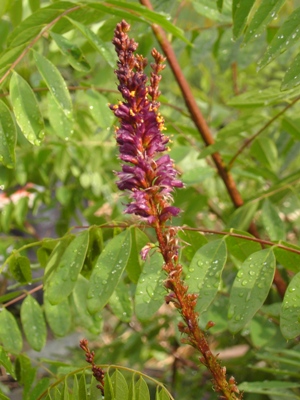1. Amorpha fruticosa L. (N-Am.) – A very rare but increasing escape from cultivation. Apparently first observed on rough ground in Antwerpen in 1953. In 1968 also seen on the verge of a railway track in Vierves (in the vicinity of a garden). Since 2002 discovered at several locations in Antwerpen: at first on the quay of river Schelde (right bank) near Petroleum-Zuid in 2002 (a very large clone, obviously present since quite a long time – possibly a mere relic from former cultivation). Subsequently also discovered at Antwerpen-Linkeroever (left bank of river Schelde) in 2005: a single specimen between basalt blocks of river Schelde (three young bushes counted by 2008 and apparently naturalising; see Verloove 2011). Amorpha fruticosa is more or less widely planted in this area (bushland in between apartments) and is regularly seen as an escape (cracks in pavement, grassland, waste land,…). Furthermore known from Wilrijk (Fort 7) and Berchem (see www.waarnemingen.be). In 2007 also discovered at two locations in the vicinity of the Petroleumdok in the port of Gent: young, single bushes – obviously self-sown. These plants are regularly mown but seem to persist very well. Additional young plants were also seen in the vicinity under a crash barrier along the Kennedylaan (2011). Since 2014 also known from a talus slope/railway siding in Kortrijk. An up-to-date overview of Belgian records is available here: http://waarnemingen.be/soort/view/125847.
Amorpha fruticosa is a very troublesome environmental weed, especially in riparian habitats, in parts of southern and eastern Europe (see for instance Doroftei 2009, Sărăţeanu 2010). In the past years it is increasingly found further north and west (see for instance Adolphi 1997, Junghans 2008). In 2016 it was found for the first time in this kind of habitat in Belgium as well (dike of river Maas near Stokkem).
 |
 |
References
Adolphi K. (1997) Neophytische Kultur- und Anbaupflanzen als Kulturflüchtlinge des Rheinlandes, 1. Nachtrag. Osnabr. Naturwiss. Mitt. 23: 27-36.
Cullen J. (1995) Amorpha. In: Cullen J. & al. (eds.), The European Garden Flora, vol. 4. Cambridge University Press, Cambridge: 500.
Doroftei M. (2009) Chorology of Amorpha fruticosa in the Danube Delta. Rom. J. Biol.-Plant Biol. 54(1): 61-67. [available online at: http://www.ibiol.ro/plant/volume%2054/Rom.J.Biol.-Plant%20Biol.,%202009,%20v.54,%20n.1,%20pp.61-67.pdf]
Gudžinskas Z. & Žalneravièius E. (2015) Notes on alien plant species Amorpha fruticosa new to Lithuania. Bot. Lith. 21(2): 160-165.
Junghans T. (2008) Zu den Vorkommen bemerkenswerter Neophyten in Mannheim (Baden-Württemberg). Flor. Rundbr. 41: 51-57.
Pedashenko H.P., Apostolova I.I. & Vassilev K.V. (2012) Amorpha fruticosa invasibility of different habitats in lower Danube. Phytol. Balc. 18(3): 285-291. [available online at: http://www.bio.bas.bg/~phytolbalcan/PDF/18_3/18_3_04_Pedashenko_&_al.pdf]
Sărăţeanu V. (2010) Assessing the influence of Amorpha fruticosa L. invasive shrub on some grassland vegetation types from western Romania. Research Journal of Agricultural Science 42(1): 536-540. [available online at: http://www.rjas.ro/index.php/rjas/article/view/553]
Tremp H. (2002) Integration von Arteigenschaften invasiver Pflanzen mit umweltfaktoren zur Erstellung von Risiko-Szenarien. Beispiel: Bastardindigo (Amorpha fruticosa L., Fabaceae). Biologische Invasionen: Herausforderung zum Handeln? 67-89.

